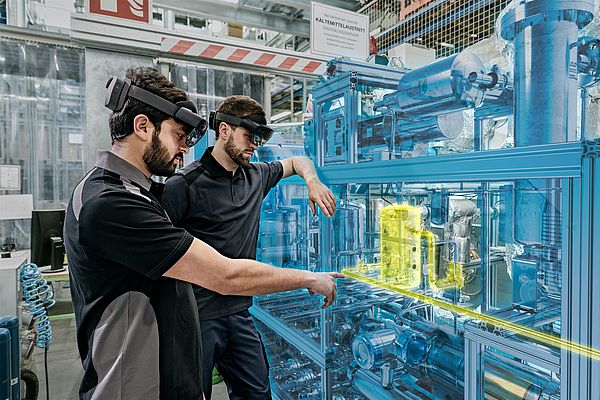How will engineers and industrial designers work in the future? Industrial companies progressively integrate Augmented Reality into their technical workflows. The Augmented Reality Engineering Space “ARES” of the AR company Holo-Light, for example, enables engineers to visualise, manipulate and collaborate on 3D CAD data in a real environment. The AR software is intended to offer engineers a new tool to optimize workflows in planning, development, and production. The following examples show the advantages Augmented Reality offers in the field already today, and also which challenges one has to face to redefine engineering workflows with immersive technologies.
Big Data Virtual Prototyping
Many industrial users can only make good use of AR if they can visualise high-polygon 3D CAD data in real-time and in high quality: For example, a detailed engine or a complete car with many millions of polygons. However, AR smart glasses can only manage smoothly up to 1,000,000 polygons. Due to this limited computing power, CAD models often have to be prepared via polygon reduction. This, in turn, reduces the quality of the 3D models to such an extent that visualisations are not very meaningful for the engineering process. A definite no-go, for example, in the design and testing of new vehicle models.
The car manufacturer BMW now uses the Augmented Reality Engineering Space with integrated remote rendering at its Munich headquarters. The remote rendering technology ISAR enables the streaming of the entire AR application. This means that the computing power does not have to come from the AR google itself but can be provided from the cloud or a high-performance, on premise server. The data also never resides on the mobile device. A crucial security feature in the event of loss of the glasses or hacker attacks.
BMW Saves up to One Year of Time
Vehicles and their components are now visualised via the AR software ARES Pro, which is linked to the BMW Group’s product data management system. Using true-to-scale visualization and interaction with concepts and prototypes previously created in CAD programs, the BMW engineers can immediately understand the accessibility, installation options and visibility of relevant assembly points in complex systems. Above all, the superimposition of real geometry with holographic 3D models enables them to evaluate different variants of a concept in minutes.
Another advantage is the collaborative working: people at different locations around the world can now employ multi-user mode to team up and review designs together and identify any errors. All in all, the BMW Group has sped up processes on vehicle module validation by as much as twelve months. Engineers were able to verify assembly processes at an early stage and adjust them efficiently for series production.
Factory Planning with Augmented Reality
Further advantages of Augmented Reality become apparent in factory planning. Planning a complete factory or new assemblies can be tricky on the computer without a real reference. Factories are constantly changing as new machines have to be installed and piping systems planned. However, data in the system becomes outdated. The only information that is actually up to date is in the field. Therefore, the digital plan and reality still diverge too often. The resulting design errors lead to downtimes. Incorrect planning can cause costs to skyrocket.
BASF was looking for a solution to bring the digital and real world together. The chemical company needed a tool to visualise and edit components true to scale in the existing factory environment. Today, BASF engineers use ARES in combination with Microsoft's AR glasses HoloLens for the planning and expansion of intermediate product plants at the headquarters in Ludwigshafen, Germany.
BASF Closes the Gap Between Virtual Planning and Reality
With the help of the Augmented Reality Engineering Space, engineers visualise planned pipelines and assemblies directly on site. Using the digital twin, it is possible to quickly determine whether planning and reality are compatible or whether changes are still necessary in the project. "What-if" test scenarios also give engineers a better understanding of their planned factory. And even during the engineering phase, on-site monitoring helps to detect and eliminate deviations early on before they lead to subsequent problems.
Factory planning has also always been a discipline that is characterized by diverse influences from different departments. The interests of mechanical and plant engineering meet the interests of civil engineering and architecture. The AR workspace also functions as a collaborative environment to bring together different stakeholders. The software suite enables a location-independent, smooth editing of complex 3D models in a collaborative space.
AR or VR - When to Use Which Technology
Basically, the field of application and the use case determine the choice of technology. In case users want to merge virtual objects with the real environment or physical prototypes, Augmented Reality is a perfect fit. Virtual Reality is particularly suitable for applications that do not yet or not fully exist in reality. With ARES VR, Holo-Light has now created also a fully immersive engineering environment, while enabling collaboration between AR and VR users. The collaborative mode allows AR and VR users – e. g. via a HoloLens and Oculus device - to connect easily and work together on virtual designs.
A Hamburg-based energy group, for example, is relying on Virtual Reality for the planning of its offshore wind farms. The development of wind turbines is a complex project involving many stakeholders and disciplines. The VR solution enables all those involved - electricians, engineers, designers, structural engineers or safety engineers - to experience and walk around the plant, which simplifies planning. For example, the system can be measured or checked for collisions. Since it is more difficult to overlay reality here because the wind farms are located at sea, VR is used.
All things considered, Virtual and Augmented Reality offer design advantages that cannot be achieved with conventional systems. Immersive technologies optimise complex engineering processes that were previously costly and error prone. Therefore, Augmented Reality Engineering should certainly be considered a future key method for engineers.
By Florian Haspinger, Co-Founder and CEO at Holo-Light



















